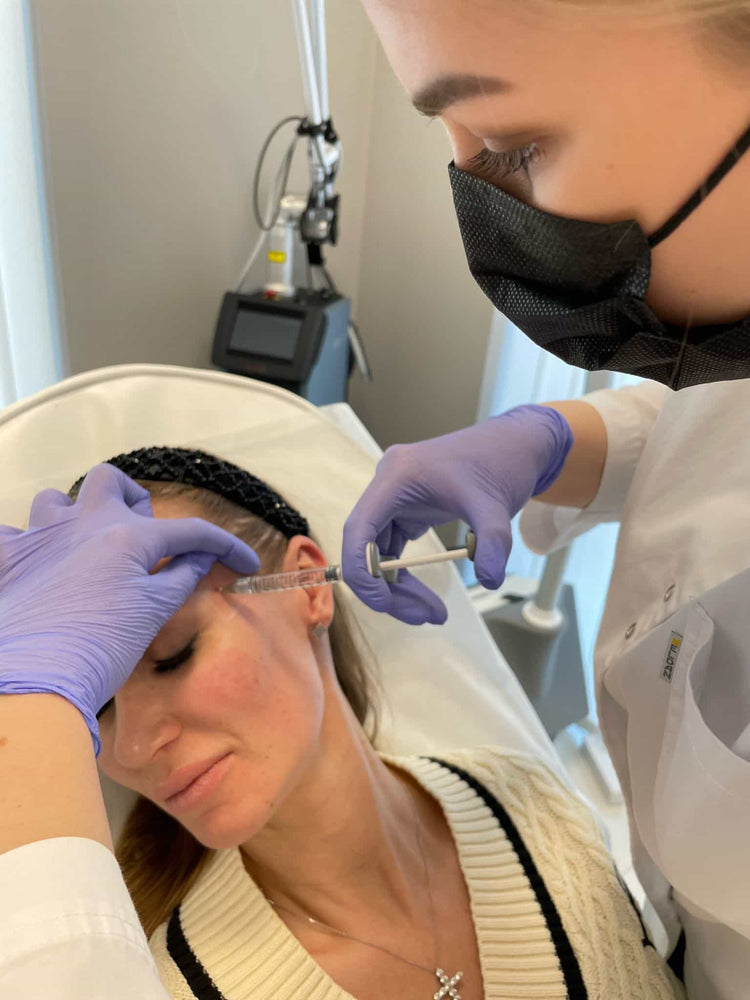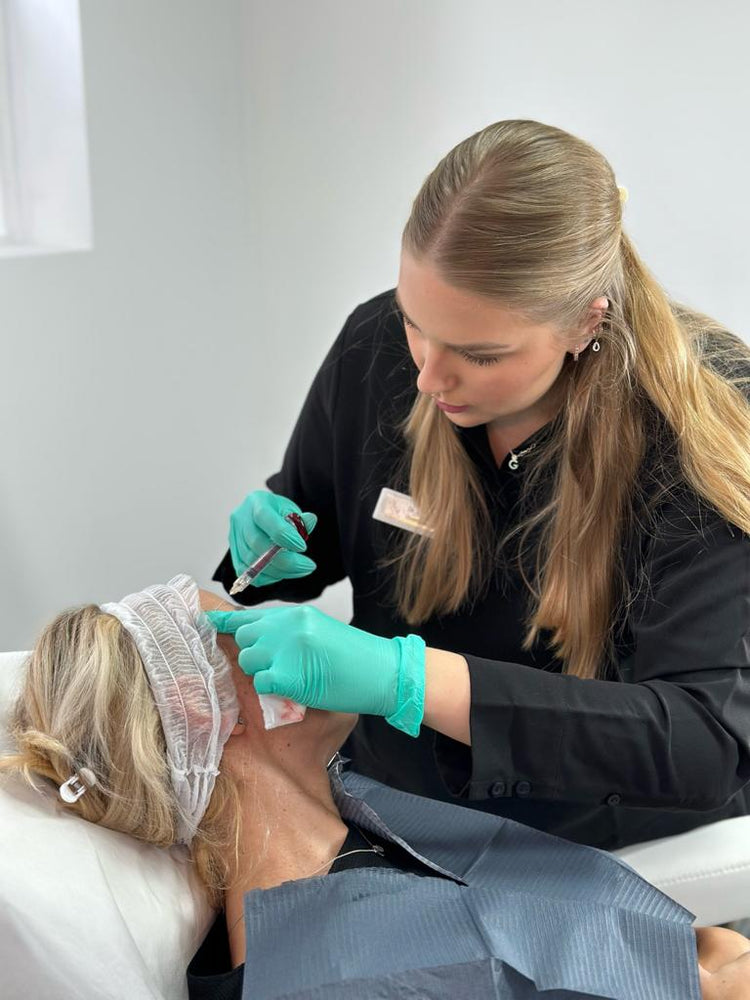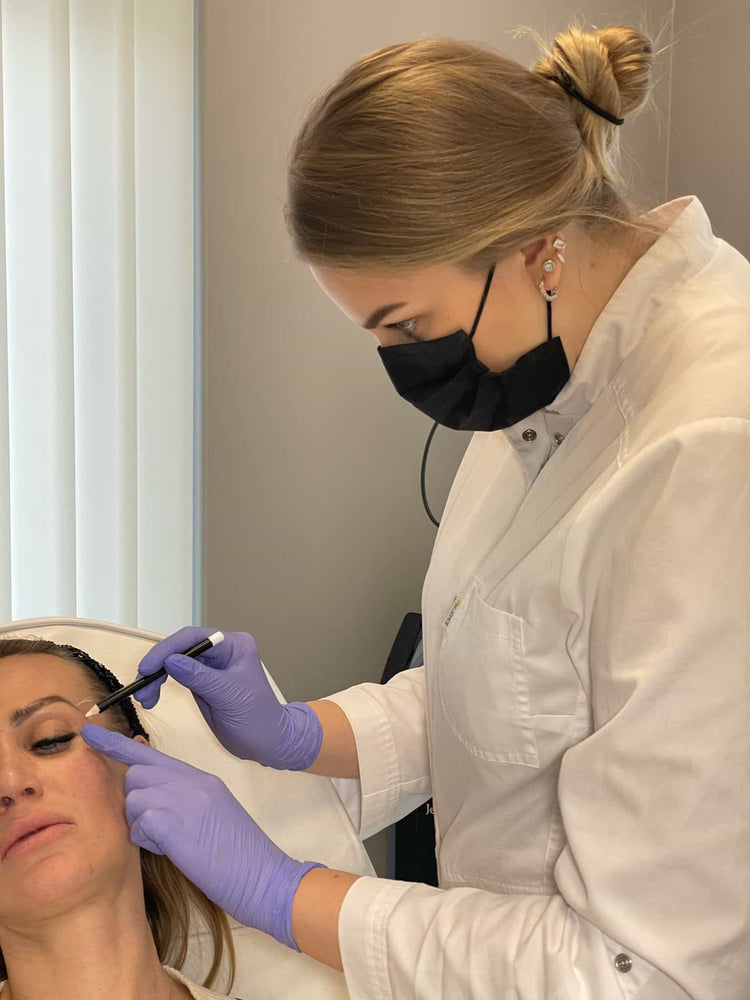What Are Hollow Temples?
Hollow temples, often described as sunken or prominent hollows on either side of the face, can affect one’s overall appearance and confidence. These depressions can be caused by various factors, including genetics, age, weight loss, or simply natural variations in facial structure. If you are concerned about the appearance of your temples, there are effective solutions available to restore fullness and create a more youthful and balanced look.
Causes of Hollow Temples
Hollow temples, often described as sunken or prominent hollows on either side of the face, can affect one’s overall appearance and confidence. These depressions can be caused by various factors, including genetics, age, weight loss, or simply natural variations in facial structure.
As we age, our skin loses elasticity and volume, leading to a more hollow appearance in areas like the temples. Weight loss can also contribute to hollow temples as subcutaneous fat diminishes. Some individuals are genetically predisposed to having less prominent cheekbones or a naturally flatter midface, which may accentuate temple hollows.
Signs and Symptoms
Hollow temples can significantly impact one’s self-esteem and appearance. They often present as noticeable indentations on the sides of the face, making it appear gaunt or aged. Several factors contribute to this condition, including genetics, age-related changes in skin elasticity, weight loss, and natural variations in facial structure.
Signs and symptoms of hollow temples include a sunken appearance on the sides of the face, a more prominent cheekbone angle, and a flattened midface. Individuals may also experience a loss of youthful volume and definition around the eye area. If you notice these changes, consult a qualified professional to discuss treatment options.
Filler Treatment for Hollow Temples
Hollow temples, characterized by sunken or prominent hollows on either side of the face, can impact one’s appearance and confidence. These depressions can arise from various factors like genetics, aging, weight loss, or natural variations in facial structure. As we age, skin loses elasticity, leading to a more hollowed look around the temples. Weight loss also contributes to this effect as subcutaneous fat diminishes. Some individuals are genetically predisposed to having less prominent cheekbones or a naturally flatter midface, further emphasizing temple hollows.
The Procedure
To address the appearance of hollow temples and restore facial volume, dermal fillers can be an effective solution. Fillers are injectable substances, typically made from hyaluronic acid, that are carefully placed into the targeted areas to plump up sunken regions.
During the procedure, a trained practitioner will inject the filler beneath the skin at precise locations around the temples. This strategic placement helps to lift and fill the hollow areas, creating a smoother, more contoured appearance. The filler gradually integrates with the body’s tissues, providing long-lasting results that can last for several months to a year.
The procedure is relatively quick and non-surgical, typically taking less than an hour to complete. Local anesthesia is used to minimize discomfort during the treatment. Patients usually experience minimal downtime after the procedure, and most can return to their normal activities within a day or two.
Types of Fillers Used
Dermal fillers are injectable substances commonly used to address hollow temples. The most popular type of filler for this purpose is hyaluronic acid (HA). HA is a naturally occurring substance in the body that helps maintain skin hydration and volume. Fillers containing HA attract and hold water, plumping up the treated areas.
Other types of fillers used for temple augmentation include poly-L-lactic acid (PLLA) and calcium hydroxylapatite (CaHA). PLLA stimulates collagen production, gradually increasing volume over time. CaHA is a mineral-based filler that provides immediate volume restoration.
Consultation Process
The consultation process for filler treatment to reduce the appearance of hollow temples typically involves a thorough evaluation of your facial structure, skin type, and aesthetic goals. During this consultation, a qualified practitioner will:
Discuss your concerns and desired outcome, taking into account your individual anatomy and preferences.
Examine your temples and surrounding areas to assess the extent of hollowness and identify suitable treatment options.
Review your medical history and any relevant medications or allergies to ensure safe treatment.
Explain the different types of fillers available and their respective properties, benefits, and potential risks.
Address any questions or concerns you may have and provide realistic expectations regarding the results.
Based on the consultation findings, a customized treatment plan will be developed, outlining the type of filler, dosage, injection technique, and anticipated outcomes.
Benefits of Filler Treatment
Hollow temples can detract from one’s facial appearance and affect confidence. These depressions can develop due to age, weight loss, genetics, or natural variations in facial structure. Dermal fillers offer a solution to restore volume and create a more youthful and balanced look.
Addressing Appearance Concerns
Dermal fillers offer a minimally invasive approach to address the appearance of hollow temples, restoring volume and contouring the face for a more youthful and harmonious look.
- Improved Facial Contour: Fillers effectively plump up sunken areas, smoothing out hollows and creating a more defined facial structure.
- Enhanced Volume: By adding volume to the temples, fillers can create the illusion of fuller cheeks and a more balanced midface.
- Minimally Invasive Procedure: Filler injections are quick, relatively painless, and require minimal downtime.
Non-Surgical Approach
Dermal fillers provide a non-surgical approach to reducing the appearance of hollow temples, offering several benefits. Fillers effectively plump up sunken areas, smoothing out hollows and creating a more defined facial structure.
By adding volume to the temples, fillers create the illusion of fuller cheeks and a more balanced midface. This can contribute to a more youthful and harmonious appearance.

The procedure itself is minimally invasive, quick, relatively painless, and requires minimal downtime.
Duration of Results
Dermal fillers offer a minimally invasive approach to address the appearance of hollow temples, offering several benefits. Fillers effectively plump up sunken areas, smoothing out hollows and creating a more defined facial structure.
By adding volume to the temples, fillers create the illusion of fuller cheeks and a more balanced midface. This can contribute to a more youthful and harmonious appearance.
The procedure itself is minimally invasive, quick, relatively painless, and requires minimal downtime.
The duration of results from dermal filler treatments for hollow temples typically ranges from six months to a year. This timeframe can vary depending on factors such as the type of filler used, individual metabolism, and lifestyle choices.
Choosing a Qualified Practitioner in Kingston Upon Thames
In Kingston Upon Thames, numerous qualified practitioners specialize in cosmetic procedures, including the use of dermal fillers for addressing the appearance of hollow temples.
Credentials and Experience
When choosing a practitioner in Kingston Upon Thames to address hollow temples with fillers, it’s crucial to prioritize credentials and experience. Look for practitioners who are registered with reputable medical boards, such as the General Medical Council (GMC) or the Nursing and Midwifery Council (NMC), ensuring they have the necessary qualifications and licenses to practice.
Experience is equally important. Seek practitioners who have a proven track record in administering dermal fillers, particularly for temple augmentation. Inquire about their experience with different filler types, as well as their approach to patient consultation and treatment planning.
Patient Reviews
In Kingston Upon Thames, numerous qualified practitioners specialize in cosmetic procedures, including the use of dermal fillers for addressing the appearance of hollow temples.
When choosing a practitioner in Kingston Upon Thames to address hollow temples with fillers, it’s crucial to prioritize credentials and experience. Look for practitioners who are registered with reputable medical boards, such as the General Medical Council (GMC) or the Nursing and Midwifery Council (NMC), ensuring they have the necessary qualifications and licenses to practice.
Experience is equally important. Seek practitioners who have a proven track record in administering dermal fillers, particularly for temple augmentation. Inquire about their experience with different filler types, as well as their approach to patient consultation and treatment planning.
Patient reviews can also provide valuable insights into a practitioner’s skills and patient satisfaction. Explore online platforms and websites dedicated to medical aesthetics to read reviews from previous patients who have undergone similar treatments.
Pay attention to the nature of the reviews, looking for consistent positive feedback regarding the practitioner’s expertise, communication style, and overall patient experience.
Location and Accessibility
In Kingston Upon Thames, numerous qualified practitioners specialize in cosmetic procedures, including the use of dermal fillers for addressing the appearance of hollow temples.
When choosing a practitioner in Kingston Upon Thames to address hollow temples with fillers, it’s crucial to prioritize credentials and experience. Look for practitioners who are registered with reputable medical boards, such as the General Medical Council (GMC) or the Nursing and Midwifery Council (NMC), ensuring they have the necessary qualifications and licenses to practice.
Experience is equally important. Seek practitioners who have a proven track record in administering dermal fillers, particularly for temple augmentation. Inquire about their experience with different filler types, as well as their approach to patient consultation and treatment planning.
- Location: Consider the practitioner’s location in relation to your residence or workplace to minimize travel time and inconvenience.
- Accessibility: Evaluate the clinic’s accessibility for individuals with mobility limitations, ensuring they have adequate parking, ramps, or elevator access.
Recovery and Aftercare
Hollow temples can affect one’s facial appearance and self-confidence. These indentations on either side of the face can be caused by various factors including age, genetics, weight loss, or natural variations in facial structure. Luckily, dermal fillers offer a minimally invasive solution to restore volume and create a smoother, more youthful look.
Post-Treatment Instructions
Hollow temples, often described as sunken or prominent hollows on either side of the face, can affect one’s overall appearance and confidence. These depressions can be caused by various factors, including genetics, age, weight loss, or simply natural variations in facial structure. If you are concerned about the appearance of your temples, there are effective solutions available to restore fullness and create a more youthful and balanced look.
As we age, our skin loses elasticity and volume, leading to a more hollow appearance in areas like the temples. Weight loss can also contribute to hollow temples as subcutaneous fat diminishes. Some individuals are genetically predisposed to having less prominent cheekbones or a naturally flatter midface, which may accentuate temple hollows.

Dermal fillers offer an effective solution for addressing the appearance of hollow temples and restoring facial volume. Fillers are injectable substances, typically made from hyaluronic acid, that are carefully placed into the targeted areas to plump up sunken regions.
- Improved Facial Contour: Fillers effectively plump up sunken areas, smoothing out hollows and creating a more defined facial structure.
- Enhanced Volume: By adding volume to the temples, fillers create the illusion of fuller cheeks and a more balanced midface.
- Minimally Invasive Procedure: Filler injections are quick, relatively painless, and require minimal downtime.
The procedure itself is minimally invasive, quick, relatively painless, and requires minimal downtime. The duration of results from dermal filler treatments for hollow temples typically ranges from six months to a year.

In Kingston Upon Thames, numerous qualified practitioners specialize in cosmetic procedures, including the use of dermal fillers for addressing the appearance of hollow temples.
When choosing a practitioner in Kingston Upon Thames to address hollow temples with fillers, it’s crucial to prioritize credentials and experience. Look for practitioners who are registered with reputable medical boards, such as the General Medical Council (GMC) or the Nursing and Midwifery Council (NMC), ensuring they have the necessary qualifications and licenses to practice.
Experience is equally important. Seek practitioners who have a proven track record in administering dermal fillers, particularly for temple augmentation. Inquire about their experience with different filler types, as well as their approach to patient consultation and treatment planning.
- Location: Consider the practitioner’s location in relation to your residence or workplace to minimize travel time and inconvenience.
- Accessibility: Evaluate the clinic’s accessibility for individuals with mobility limitations, ensuring they have adequate parking, ramps, or elevator access.
Potential Side Effects and Complications
Recovery after dermal filler treatment for hollow temples is typically quick and easy. Most patients experience minimal downtime and can return to their normal activities within a day or two.
Possible side effects are usually mild and temporary. They may include redness, swelling, bruising, tenderness, or itching at the injection sites. These effects usually subside within a few days to a week. In rare cases, more serious complications may occur, such as infection, allergic reactions, or uneven filler distribution. It’s important to follow your practitioner’s post-treatment instructions carefully and seek medical attention if you experience any severe or persistent side effects.
Follow-up Appointments
Recovery after dermal filler treatment for hollow temples is typically quick and easy.
Most patients experience minimal downtime and can return to their normal activities within a day or two.
Possible side effects are usually mild and temporary. They may include redness, swelling, bruising, tenderness, or itching at the injection sites. These effects usually subside within a few days to a week.
In rare cases, more serious complications may occur, such as infection, allergic reactions, or uneven filler distribution. It’s important to follow your practitioner’s post-treatment instructions carefully and seek medical attention if you experience any severe or persistent side effects.
Follow-up appointments are essential to monitor the results of your filler treatment and ensure proper healing.
Your practitioner will typically schedule a follow-up appointment within a week or two after your initial treatment to assess the placement of the filler, check for any side effects, and make any necessary adjustments.
During follow-up appointments, you can also discuss any concerns or questions you may have about your results or the treatment process.
Depending on the type of filler used and your individual healing process, additional follow-up appointments may be recommended to maintain optimal results.
Enquire about Temple Filler for a smoother, lifted look with Dr. Laura Geige at It’s Me & You Clinic
- Who Should Not Get Under Eye Fillers? - November 4, 2025
- What Is Russian Lip Filler Technique - November 3, 2025
- Weed Drinks That Taste Like Real Cocktails - November 1, 2025
